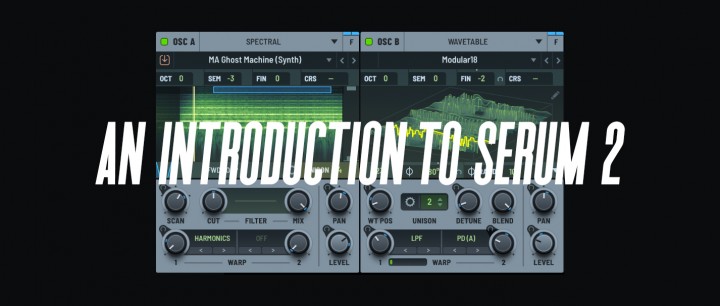
So, the news finally broke early last week that shook the internet - the long rumoured sequel to Serum, one of the most popular software synthesisers ever created, is available at last!
Serum 2 is an upgrade on the original in pretty much every conceivable way, packing in at least double the synthesis and sound design heft of its first iteration for our money.
Speaking of money, one of the best things about Serum 2 is that it is an entirely free update for existing Serum license holders, with Xfer Records founder and Serum creator Steve Duda sticking firmly to his word of lifetime free updates for the synth.
If you have a Serum license and haven’t upgraded yet, we can not recommend doing so enough - having already logged weeks in the studio tweaking away with its every dial and detail in the creation of our first set of presets for it, Dusk - Serum 2 Ambient Presets, we can tell you that this is one of the most inspiring, fully-featured sound design tools we’ve ever used!
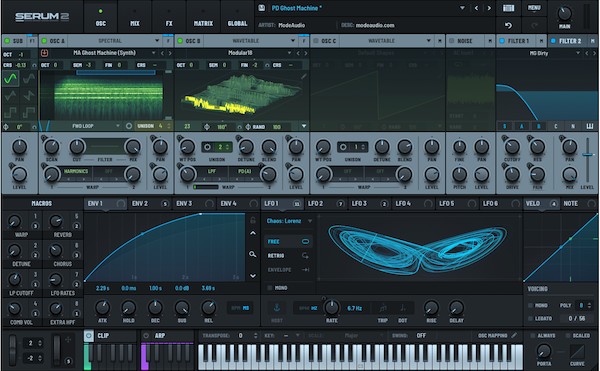
Today, we’d like to give you a brief tour through Serum 2’s new features through the prism of presets taken from our new Dusk pack, a couple of which are free to download over on the pack page, with more extensive coverage and tutorials to following in the coming months.
We honestly can’t wait for the music production community to get its teeth into Serum 2, nothing less than a mad scientist’s playground for sounds of pretty much every shape and size. Let’s get straight to it!
Bigger, Badder
The first thing you’ll noticed when loading up Serum 2’s interface is that it’s wider than the original; more tabs, macros, modulators and features in general have made it necessary to stretch the GUI out, which comfortably houses the many dials, sliders and buttons Serum 2 offers for sound manipulation.

We are also now offered a 3rd oscillator, in addition to the sub and noise oscillators from Serum 1, providing even more scope for layering and thickening up your patches.
Serum 2 can be broadly broken into 6 main components; synthesis, filtering, modulation, effects, mixing / routing and arpeggiator / clip launcher.
We're going to take a look at the first 4 today, hearing some sound examples from Dusk along the way - this doesn’t cover everything but understanding these sections gets you a long way towards creating beautiful sounds with the synth.
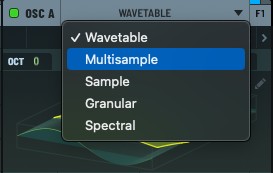
Synthesise Your Life
A synth sound needs to start with, well, some form of synthesis (the clue is in the name, right?!), and Serum 2 improves on Serum 1’s humble wavetable synthesis with a further 4 options, bringing the total to 5: wavetable, multi-sample, sample, granular and spectral. Quite the list, I’m sure you’ll agree!
For us, these additional synthesis modes are the beating heart of Serum 2 and represent the biggest upgrade over Serum 1 and, well, pretty much any other soft synth currently available on the market.
As mentioned above, we’re going to be spending a lot of time in the coming months homing right in on the detail of Serum 2's various features and facilities, so for now, let’s just give a brief rundown of what these synthesis modes are and how they sound.
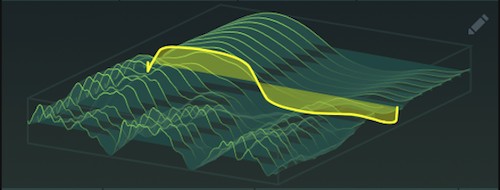
Wavetable
The wavetable synthesis mode is your ‘classic’ option ported from Serum 1, using short sound files to essentially store waveform or shape information in the form of up to 256 'frames', which are then looped at high speed, or oscillated, to create continuous, pitched tones.
Here’s a quick example, from Dusk, of some stacked wavetable oscillators, taking advantage of Serum 2’s vast new list of factory wavetable samples, culled from both analog and digital synths and sources:
Pretty thick and lush, right? This is relatively similar to what you can already achieve in Serum 1, so let’s quickly move onto the other synthesis types.
Multi-sample & Sample
Multi-sample and sample both, you may have guessed, use external audio files to feed into Serum 2’s plethora of filtering, effects and modulation options - the difference with the wavetable synthesis mode is that the samples are typically much longer, measured in milliseconds and seconds rather than down to the much more cellular 'sample' level.
These modes are used for playing back recorded acoustic piano notes for example, faithfully reproducing the natural ADSR phases and timbral development of these complex sounds, rather than taking a tiny wavetable snapshot, cycling through it quickly, and relying on imitation using enveloping, filtering etc to approximate the sound.
Multi-sample allows the user to specify key and velocity zones, so that different samples are triggered for different MIDI pitches and at different velocities to create a more authentic, nuanced overall effect, whereas the sample mode simply stretched a single sample across the entire keyboard range.
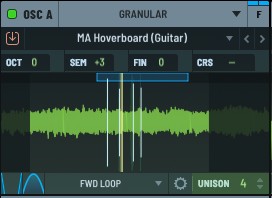
Granular
We now come to probably our favourite new feature of Serum 2 - the granulator. It’s no secret that we here at ModeAudio have been in love with granular synthesis since we first starting making music with computers, so having a dedicated, powerful granulation engine at our beck and call within one of our favourite synths around is nothing short of a revelation!
We’ve covered granular synthesis in greater detail elsewhere, so we’ll keep our description brief here - essentially, we’re dealing with loaded samples which, instead of simply being played back from start to finish, are played back in short, overlapping segments, like several tape heads playing back snippets of sound almost at the same time.

This creates wonderfully fragmented, unpredictable results yet with perceptible sonic contours, forming sound into tiny droplets, or huge, crashing waves and gargantuan, hovering clouds.
Serum 2 makes all the usual parameters available, with grain length, density and scan rate being the most important. Random playback offset, playback direction, pitch, length, panning and volume are all given dedicated dials also, making for wonderfully pliable sound-sculpting tools, injecting a more natural, organic feel into the granular engine when used sparingly.
Here’s a quick demonstration of the granular synthesis mode, demonstrating the ‘GRAN Hoverboard’ preset from our Dust pack which uses a custom ModeAudio guitar drone sample:
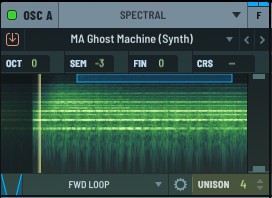
Spectral
The final synthesis mode offered in Serum 2 is another truly exciting, market-shaking inclusion - spectral synthesis.
Again, it’s beyond the scope of this article to fully dive into the principles behind spectral synthesis (see here for a Quick Tip covering spectral processing however), but essentially what we’re dealing with is the analysis of an input audio file or signal, which is then re-synthesised using noise and tuned filters to recreate the harmonic make-up, or spectrum, of the input sound.
We’ll go into the specifics of all of this in another article, but what you really need to know right now is that this is a very exciting addition to the Serum 2 synthesis architecture, offering up an entire world of ghostly, ethereal sonic possibilities.
Here’s another example from Dusk, this time showcasing the ‘PD Ghost Machine’ patch also using a custom ModeAudio synth drone sample as the input for spectral analysis:
Warp Speed
Now we’ve covered the 5 synthesis modes offered in Serum 2, let’s briefly mentioned probably the most distinctive and essentially signature feature from Serum the elder - warping.
From those intense Dubstep bass shrieks through to the subtle, slow-moving evolutions heard in Ambient pads, Serum’s warp modes are a big part of what put the synth on the map originally, and as with all the other features offered in the first version, Serum 2 offers upgrades on this celebrated corner of its synthesis architecture.
Alongside all the ‘classic’ warp modes such as Pulse Wave Modulation, Asymmetrical, Mirror and Flip, we now have filtering and distortion options offered at this point in the signal chain, as well as amplitude, ring, FM and phase distortion modulation and, for the spectral synthesis mode, a whole host of harmonic smearing, bending and breaking options thrown up.
Dual warp modes are also offered per oscillator now, so you can blend and meld different flavours for more complex results.
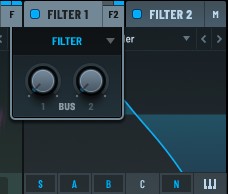
Filter Town
Filtering, though crucial to the sound design process and patch creation in general, remains pretty much the same in Serum 2 as in the first version, though we have a few interesting new filter modes to choose from this time.
One change however is that 2 main filters are offered instead of just 1, with parallel and series routing configurations possible with the turn of a dial. So, you can now feed the output of a low pass filter straight into a comb filter, or flange filter into a band pass for all kinds of interesting and unique results.
Mod Cons
Moving onto modulation, it’s a similar story; the picture is largely the same as with Serum 1, except we’re offered more envelopes (4 vs 3) and LFOs (6 vs 4) this time around. One big addition however, is that 2 brand new, chaos-inspired LFO modes are included, labelled Rossler and Lorenz after the scientists that birthed the mathematical equations behind each.
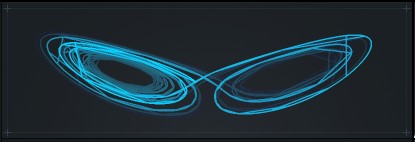
Essentially, the two modes create chaotic patterns at the specified frequency rate, with the user now able to assign both the X and Y axis for modulation purposes independently. They also both happen to produce visually beautiful patterns, which we found ourselves often getting lost staring at for far too long whilst making Dusk!
All For Effect
Let’s finally turn our attention to Serum 2’s onboard effects - aside from offering all the effects found under the hood in Serum 1, we now have a whole of other options to play with.

From utilitarian additions such as the very literally titled Utility effect, offering basic filtering and stereo width functions, and various splitter effects such as low / high frequency and mid / sides for separating out your effects processing in the stereo field, to fruitier newcomers such as the Bode frequency shifter module and convolution effect, Serum 2 houses a veritable playground of effects processing that we’re struggling to find any gaps in.
The convolve effect in particular is a welcome sight for us here at ModeAudio, being lovers of all things convolution reverb - Serum 2's pre-packaged impulse responses range from guitar cabinets and vinyl clicks to epic, imagined reverb spaces.

It’s A Wrap
We’ve really just scratched the surface with our rundown of some of the main upgrades and new features offered in Serum 2 above - let us just also briefly point out that the new bus routing functionality and extensive gain staging on offer are just a couple of the game-changing functions the synth now makes available that we simply don’t have time to fully cover here.
In a nutshell, Serum 2 is an astonishing improvement on what was already just about the best-loved soft synth out there, an exciting quantum leap into the future of electronic music-making. The fact it is fully backwards compatible with all your existing Serum 1 presets also is just the cherry on top!
If you’re already a Serum user, we strongly urge you to upgrade and don’t forget to check out our brand new set of presets for the synth as featured above, showcasing all the exciting new features and tools the synth has to offer. Until next time, get creative!











